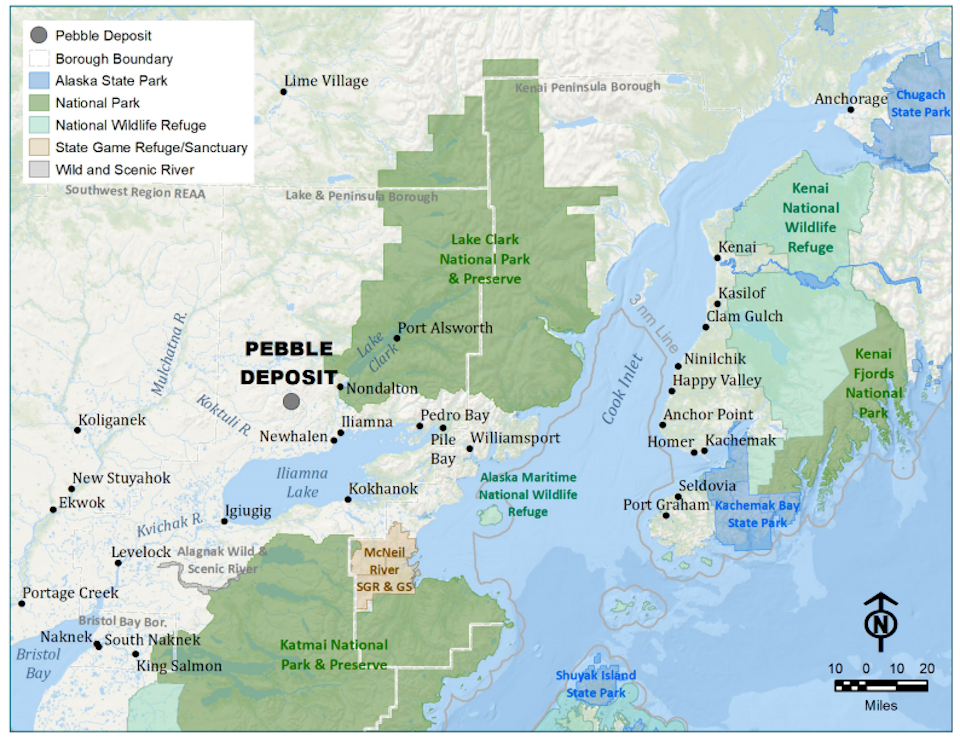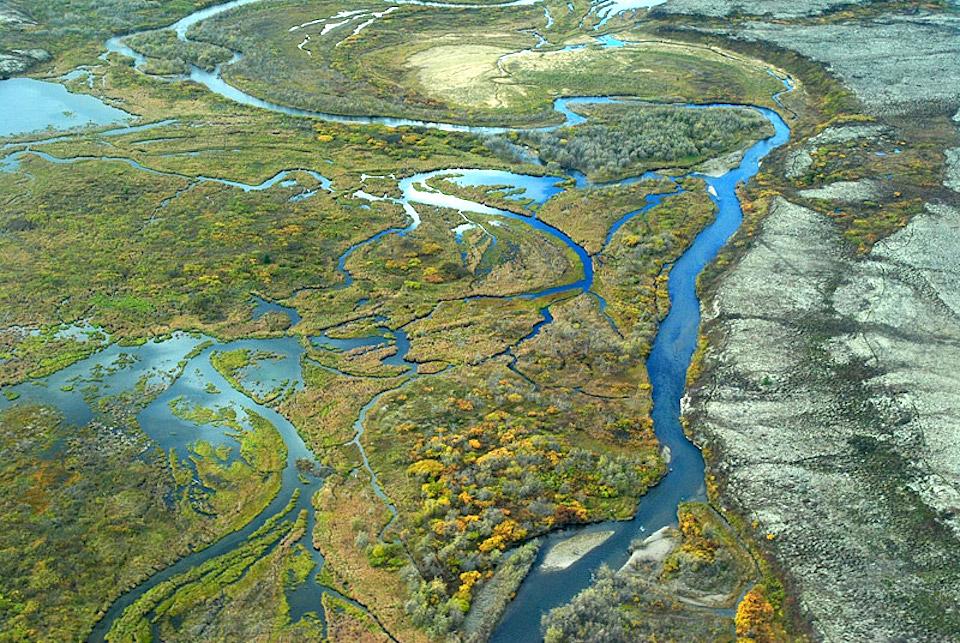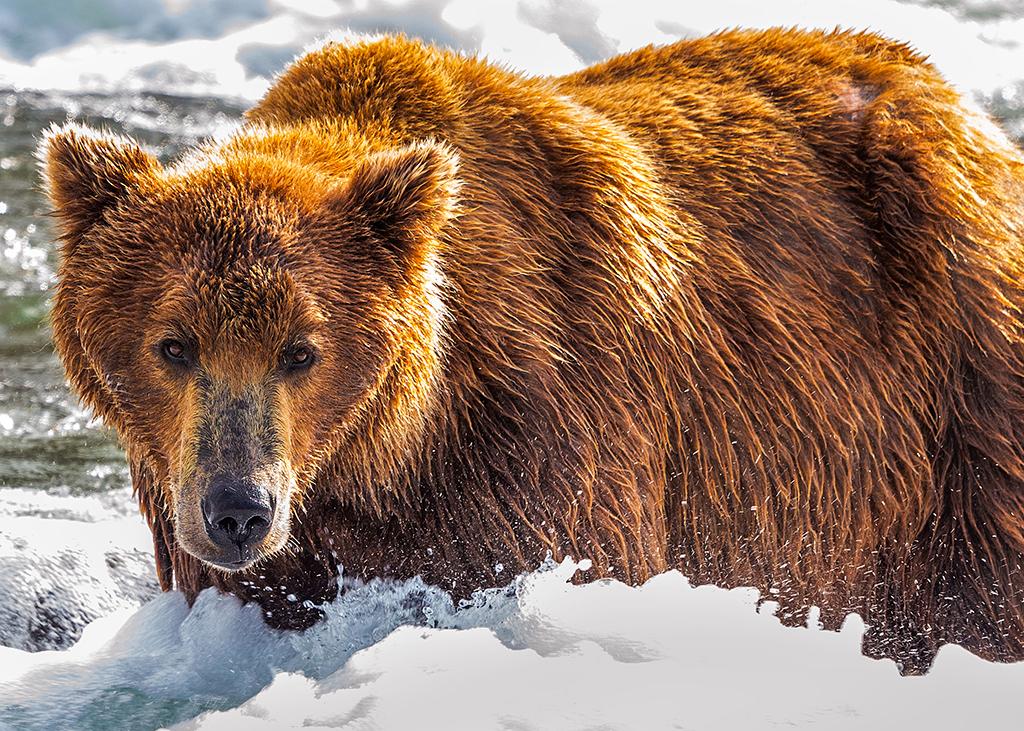
The U.S. Army Corps of Engineers says the proposed Pebble Mine wouldn't have a great impact on the Bristol Bay fishery/USACE
In a 180-degree reversal of an Obama administration finding, the Trump administration on Friday said an open-pit copper, gold, and molybdenum mine on the doorstep of Lake Clark National Park and across from Katmai National Park in Alaska would not harm the fisheries of Bristol Bay, a decision quickly denounced by conservationists.
The setting is an environmental and cultural wonderland. The proposed Pebble Mine would lie at the headwaters of two of the largest tributaries of Bristol Bay, and is directly between Lake Clark National Park and Preserve and Katmai National Park and Preserve. Fishermen, homesteaders, Native Americans, and fish and wildlife all depend upon this pristine area for life itself. Bristol Bay supports the largest sockeye salmon fishery on Earth.
Into this setting the mine's proponent, Northern Dynasty Minerals, wants to build its mine along with "an 82-mile road, pipeline and utilities corridor to a permanent, year-round port facility on Cook Inlet, a lightering location in Iniskin Bay, a 164-mile natural gas pipeline from existing energy infrastructure on the Kenai Peninsula to the Pebble mine site, a 270 MW natural gas-fired power plant at the mine site and smaller power generation facility at the port site."
It was just six months into President Trump's tenure that the Environmental Protection Agency opened a 90-day comment period on its proposal to withdraw an Obama administration decision to restrict the discharge of dredged or fill material associated with the potential “Pebble Mine.” Without the requisite Section 404 discharge permit, the project couldn't move forward.

Some of the wetlands in the area of the proposed open-pit mine/EPA
Back in 2014 the Obama administration decided that the project posed too much of a threat to the fisheries' rich Bristol Bay waters to permit it and put the brakes on the so-called Pebble Mine project. In studying the project, which would be roughly 14 miles from Lake Clark, the EPA at the time said that upwards of 100 miles of streams that might be valuable to "spawning or rearing habitats for Coho salmon, Chinook salmon, Sockeye salmon, rainbow trout, and Dolly Varden (trout)" could be lost or blocked by the Pebble proposal; that more than 4,000 acres of wetlands providing "off-channel habitat" for fish could vanish under the mine's potential footprint, and; that impacts to surface and groundwater flows could harm winter and spring fish habitat.
In short, the Obama administration found the simple existence of large-scale mining operations could adversely affect the culture and environment of the area.
On Friday, the U.S. Army Corps of Engineers released its final environmental impact statement on the project, stating, in essence, that the Obama administration was wrong and that the project with its 20-year life could move forward without great threat to the environment.
"Overall, impacts to fish and wildlife would not be expected to impact harvest levels. Resources would continue to be available because no population-level decrease in resources would be anticipated," the EIS's Executive Summary stated.

The EIS was inconclusive on how the mine project might impact bear viewing at Katmai National Park and Preserve/Rebecca Latson file
In sum, the EIS said the preferred alternative would "not be expected to measurably affect the health or value of Bristol Bay salmon fishery, including permit holder earnings, permit holder value, crew earnings, fishery first wholesale values, processor earnings, or local fiscal contributions."
Regarding recreational fishing, the Corps held that "(C)onstruction activities would be disruptive and truck traffic would adversely affect the recreation experience that occurs in the vicinity of the road for those anglers that prefer a more remote experience. Fishing effort should not be adversely affected overall, but in terms of extent may be redistributed along the waterbodies as long as fish populations are unaffected by changes in distribution of fishing effort."
Officials at Northern Dynasty, a British Columbia-based company, applauded the findings.
“We’re ecstatic to reach this major milestone in the advancement of the Pebble Project – a modern mineral development proposal that has the potential to become one of the most significant metals producers in the United States, and a major source of jobs, investment, economic activity and government revenues in Alaska,” said Northern Dynasty President & CEO Ron Thiessen.
“There is more work to be done, but the publication of the Final EIS today is a clear validation that Pebble can be developed in an environmentally sound and socially responsible way, creating benefits and opportunities for the people of Bristol Bay and all Alaskans," he said.
However, the company still needs to find a "major mining company" (or companies) to partner with it on the project.
Opponents of the project were united in their belief that the Corps rushed through its analysis and overlooked more than a few things.
“It’s a reoccurring nightmare that won’t end. For decades now, the shortsighted proposal of Pebble Mine has threatened to poison Bristol Bay, destroy the world’s largest remaining wild sockeye salmon fishery, and spoil critical habitat for the endangered Cook Inlet beluga,” said Katharine Bear Nalven, Defenders of Wildlife Alaska representative. “Bristol Bay is the lifeblood of Alaska. We will not sit idly by as the Pebble project further imperils a beleaguered population of endangered belugas and wipes out a world-class salmon fishery.”
The Corps of Engineers itself acknowledged there were some unknowns. For instance, how the project might impact bear viewing at Katmai National Park was hard to say, the hefty document said.
"Recreational wildlife viewing opportunities at existing bear-viewing facilities at McNeil River State Game Refuge and Katmai National Park and Preserve may be affected, but the nature and extent of changes cannot be predicted," wrote the authors.
That EIS's conclusions that the project would not greatly impact the environment were attacked by many conservation and environmental organizations, including the National Parks Conservation Association.
"The Army Corps’ final rushed review continues to determinedly ignore the threats Pebble Mine poses to Katmai and Lake Clark national parks’ brown bears and the world’s largest wild sockeye salmon run," said Jim Adams, NPCA's Alaska regional director.
“Pebble Mine and its related transportation corridor spells disaster to the world’s densest population of brown bears, including those that travel from world-famous Katmai National Park," he added. "Analysis of such threats and other impacts to wildlife and wild places are missing from this review, which instead solely focuses on ramming through this disastrous mine."
Taryn Kiekow Heimer, deputy director, marine mammal protection project, nature program, at the Natural Resources Defense Fund, said the EIS was rife with gaps.
"There are a wide array of issues that undermine the integrity of the final EIS and the permit process as a whole, including continuing to ignore missing information and allowing baseline data collection and various scientific studies to occur after the EIS and permitting decisions are made," she wrote in a blog. "Wetlands, rivers, and streams that will be impacted by the proposed mine still have not been mapped. Fish, water quality, hydrologic studies, and wildlife surveys remain missing or incomplete. Most egregious, the Army Corps continues to limit tribal consultation."
Legal challenges to the EIS's conclusions are expected, and more permits from the state of Alaska would be needed for the project to move forward.



Comments
This is extremely bad. The environmental riches of that area have depend on feeding during the summers and the broad base of that food web depends on the aquatic resources, both ground and surface waters. Everything there depends on what lives in those waters, what flies out of those waters, what uses those waters to bring oceanic nutrients up and make them available to the freshwater and terrestrial systems, what reproduces in that water, and what those waters raise and make available to perpetuate the ecosystem. This project will hit those resources the hardest It is absolutely no exaggeration to say that a mine of this type and size located right in the knickers of the Iliamna Lake system is truly in the worst location possible in terms of environmental damage.
There is absolutely no possible way this project can be developed in an environmentally sound and socially responsible way. Over and over, mining companies have always said similar things about similar projects, only to cut and run when things go wrong and the question of reclamation costs comes up. From an environmental standpoint, this project is guaranteed to be bad at best, while carrying a very real risk of being a complete environmental disaster, with the public left to pay for the clean-up, at worst. It's only a matter of time.
From a social responsibility standpoint, we've seen that movie before as well. Yes, during the "boom" times, some dangerous, unsafe, and unhealthy mining jobs will be created; but, those jobs will ultimately just seduce workers to become dependent on a foreign company. They will delay or decline education and training that might have given them better and more stable careers and they'll suffer as a result. Then, frequently disabled by the injuries and health effects that beleaguer "formerly employed miners" everywhere and abandoned when the company dissolves itself and the profiteers once again cut and run, they will linger on, damaged, depressed, unemployable, impoverished, and hopeless in the kind of communities we've all seen, over and over, from the coal country of West Virginia, to the fracking oil patches of the Dakotas, to the abandoned drilling sites of the North Slope, to the uranium mines of the southwest, to Butte and Anaconda, and even to the Imperial Metals disaster at Mount Polley, right in the backyard of Northern Dynasty in British Columbia. I wouldn't be surprised if some of the people involved with that Imperial Metals disaster at Mount Polley weren't also involved with Northern Dynasty. When the feces hit the propeller at Polley Lake, that company cut and run and Northern Dynasty will too.
No, this mine will really never be a good thing. It's only a matter of time before it will inevitably be recognized as what it is, an extremely bad idea hawked by a bunch of extremely bad people.
The Army Corps of Engineers ... isn't that the same entity that did a complete flipflop regarding damage caused by Burnett Oil Co at Big Cypress National Preserve? I've visited both Katmai National Park & Preserve and Lake Clark National Park & Preserve and this gives me a really bad feeling. But, does it surprise me? No, not with this current administration.
As a former Alaskan, I have to voice agreement with the prior two posters. Until recedntly I has thought the Army Corps of Engineers to be apolitical, but they they did the absolute "see no evil"report on Burnett Oil, and now this. I now regret paying no attention to whatever political appointments were made out of the Plum Book, q.v.
Agreed, I've been following this for the last 10 years. Perhap, LWCF Funds can buy out Northern Dynasty's share of the Pebble Deposit. Depressing as anything. I have spoken.
Based on the apparent impropriety and blatant political interference of this NEPA finding of No Significant Impact, I suspect that this will find it's way to the courts post haste... At least I hope it will.
The Army Corps of Engineers also flip-flopped on granting a 404 permit to let another Canadian mining company, Hudbay Minerals, dig a huge open-pit mine in the Santa Rita Mountains south of Tucson. Until the Trump administration, the COE thought granting such a permit was a bad idea. Hmmm....
Oh my I couldn't agree more with previous comments. Another project our President has approved that will probably only benefit his friends in "the good ole boys club", but not the Alaskans, animals, or environment of the area. Yes, the study states only minimal impact - DAH famous last words! The administration has undermined the need to work toward decreasing our emissions and protecting the country for future generations. No matter what you believe it is obvious the planet is experiencing warmer weather. I feel it's partially our actions and partially a cyclical change, but we need to stop being part of the problem and be part of the cure. I've just one more thing to say, I feel President Trump is part of the problem but am SO disappointed in the 535 men and women in Congress that shirk their responsibility year after year and I feel they are the ones mostly to blame. Sorry...will get off my soap box now.
Not living in America Alaska, I follow the news, I have to say President Trump is a money grabbing mentally poor man. Open pit mining will do no end of damage to the ecosyste, the bears will suffer and other animals, this has not been thought through at all, it was probably decided when the 'good old boys' were having drinks, then one of them said "hey why don't we do some mining up north?" The other old boys agreed, no one dared to say NO.
I feel so sorry for the people there, the animals that will be slautered by gun happy idiots.Americans need to take the government to Court and stop this wanton destruction